Dynamics of Particles Interview Questions and Answers:
1. Define Dynamics.
Ans. It is the branch of science which analyze the characteristics of particles/bodies in motion.
2. Define Kinematics.
Ans. It is the study of motion of a body or of a particle without considering the forces causing the motion of it.
3. Write some examples of Kinematics.
Ans. Displacement, velocity, acceleration, Trajectory motion.
4. Define Kinetics.
Ans. It is the study of motion of a body or of a particle by considering the forces causing the motion.
5. Name some examples of Kinetics.
Ans. Tractive effort, thrust in jet propulsion.
6. Differentiate between the motion and rest of a body.
Ans. A body is said to be in motion if it is changing its position with respect to its surrounding. A body is at rest when its position remain unchanged with respect to its surrounding.
7. Define the term displacement.
Ans. Change in position of a body with respect to a given object is known as its displacement.
8. Define Speed.
Ans. It is defined as the rate of change of displacement irrespective of its direction.
9. Define Velocity.
Ans. It is the rate of change of displacement in a particular direction. It is a vector quantity.
10. Distinguish uniform and variable speed.
Ans.
If the magnitude of speed of a body remains constant throughout its motion, then it is uniform speed.
If the speed changes with respect to time during the motion, then it is variable speed.
11. Define Uniform Velocity.
Ans. If the body covers equal distances in equal intervals of time, it is said to move with uniform velocity.
12. Define Acceleration.
Ans. It is defined as the rate of change of velocity.
13. What do you understand by Acceleration and Retardation?
Ans. Acceleration refers the increase in velocity of the body with time. Deceleration (or) Retardation refers the decrease in velocity of the body with time.
14. Write the equations of uniform accelerated motion.
Ans.

15. If a body is subjected to force of gravity, write the equations of motion.
Ans.

16. What are the types of motion?
Ans.
- Translation
- Rotation
17. Define Translation.
Ans. When a straight line drawn on the moving body remains parallel to its original position at the given time, then it is called as Translation.
18. What are the classification of Translation?
Ans.
- Rectilinear Translation
- Curvilinear Translation
19. Define Rectilinear Translation.
Ans. If the path traced by a point on a body is a straight line, then it is called as Rectilinear motion.
20. Define Curvilinear motion.
Ans. If the path traced by a point on a body is a curve and the line drawn on the body remains parallel to its original position, then it is called as Curvilinear Translation.
21. Define Rotation.
Ans. When the particles of the body move in a concentric circular path then it is said to be Rotation.
22. Write the differential equations of motion.
Ans.

23. Name the coordinates followed to define curvilinear motion.
Ans.
- Rectangular (or) Cartesian Coordinate
- Normal and Tangential Coordinate
- Polar Coordinate
24. Write the expression for normal and tangential components of accelerations?
Ans.

25. Write the expression for acceleration in polar coordinates.
Ans.

26. Define Projectile.
Ans. The curved path traced by the freely projected particle which moves under the combined effect of vertical and horizontal motion is called as Projectile.
27. Define velocity of projection.
Ans. The velocity with which the particle is freely projected in the air is called as velocity of projection.
28. Define angle of projection.
Ans. It is the angle at which the particle is projected, the angle being measured with the horizontal.
29. Define Trajectory.
Ans. The path described by the body in motion is called as Trajectory.
30. What do you mean by horizontal range?
Ans. It is the distance between the point of projection and the point where the path of projectile meets the plane again, drawn through the point of projection.
31. Define Time of flight.
Ans. It is the time interval between the instant a projectile is projected and the instant when it meets the horizontal plane through the point of projection.
32. Write the expression for equation of path of projectile.
Ans.

33. Write the mathematical expression for calculating horizontal range
Ans.

34. State D ‘Alemberts principle’.
Ans. The system of a forces acting on a body in motion is in dynamic equilibrium with the inertia force of the body.
35. Define the unit Newton.
Ans. Newton is defined as that force which acts on a body of mass one kg and produces an acceleration of 1 m/sec2 in the direction of force.
1·N = 1 kg – m/sec2
36. What is work of force of gravity?
Ans. Consider a particle of mass ‘m’ moving along the path in vertical plane in upward direction through a distance ‘dy’.

37. Write the expression for work of the force of spring.
Ans. The expression for work of the force of spring is

38. Define energy.
Ans. It is defined as the capacity to do the work.
39. What are the different forms of energy?
Ans.
- Potential energy
- Kinetic energy
40. What is meant by Potential energy?
Ans. It is the capacity to do work due to the position of the body.
41. Define Kinetic energy.
Ans. It is the capacity to do work due to the motion of the body.
42. Define Power.
Ans. Power is defined as the rate at which work is done.
43. Write down the equation for dynamic equilibrium.
Ans.

44. Write the work energy equation
Ans.

45. Define Conservative force?
Ans. If the work of force is moving a particle between two positions independent of the path followed by the particle and can be expressed as a change in its potential energy, then such a force is called as Conservative force.
46. Define law of conservation of energy.
Ans. The sum of kinetic and potential energies of the body/particle remains constant. This is called as law of conservation of energy. i.e) E = T + V
47. Define Impulse.
Ans. It is defined as the large force acts on a body over a short period of time.
48. Define Momentum.
Ans. The product of mass and velocity is termed as momentum (or) Linear momentum.
49. Write the Impulse momentum equation.
Ans. The equation for impulse momentum is = m (V2 -V1)
50. What is the unit for momentum?
Ans. Newton-sec.
51. Write the principle of conservation of momentum.
Ans. It may be stated, that the momentum is conserved in a system in which the resultant force is zero. Otherwise the total momentum of system remains constant, if there is no external force acting on it.

52. Give two examples for momentum.
Ans.
- A bicycle continues its motion upon certain distance even if pedaling is stopped.
- A vehicle does not immediately stop after its fuel supply is cut off.
53. What is Angular Momentum?
Ans. The product of mass moment of inertia (I) and angular velocity (ω) of a rotating body is known as moment of momentum or angular momentum. It is equal to Iω.
54. What is Hodo graph?
Ans. Let a particle has a velocity ‘V’ at time ‘t’ and a velocity ‘V’ at p and p’ respectively as shown in fig. (a). To study the time rate of change, the two velocity vectors are plotted such that their tails are located at the fixed point ‘o’ and their arrow heads touch points the dashed curve as shown in fig (b).

55. Define Impact
Ans. The collision of two bodies is called as impact, when they are in contact for a very short period and exert very large amount of force on each other during that period.
56. What is meant by line of impact?
Ans. The common normal to the colliding surface (or) the line joining the centre of two bodies with the point contact is known as Line of Contact.
57. Classify Impact.
Ans.
- Direct impact.
- Oblique impact.
- Central impact.
- Eccentric impact.
58. Define Direct impact.
Ans. Direct impact is the type of impact in which colliding bodies are along the line of impact before collision.
59. Define Oblique impact.
Ans. Oblique impact is the type of impact in which the motion of the colliding bodies are at some angle to the line of impact before collision.
60. What is Central Impact?
Ans. Central impact is defined as the impact in which the mass centres of the body are lying on the line of impact.
61. What do you mean by eccentric impact?
Ans. Eccentric impact is the type of impact in which the mass centres are not lying on the line of impact.

69. Define dynamic equilibrium.
Ans. A body will be in equilibrium if the sum of all forces acting on the body is zero. Such equilibrium is called dynamic equilibrium.
70. Give examples to D ‘Alembert’s principle
Ans.
- Motion of two bodies connected by string
- Motion of a lift.
71. Define work of a force.
Ans. If a particle is subjected to a force (F) and the particle is displaced by an infinite final displacement (ds) the work done (du) by the force = F x ds x cos α
